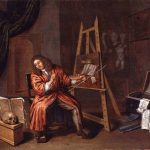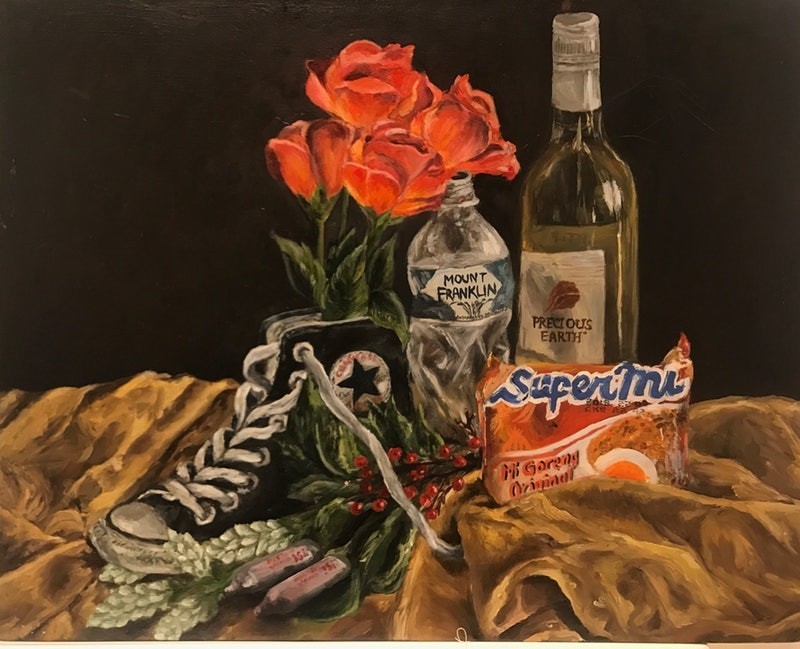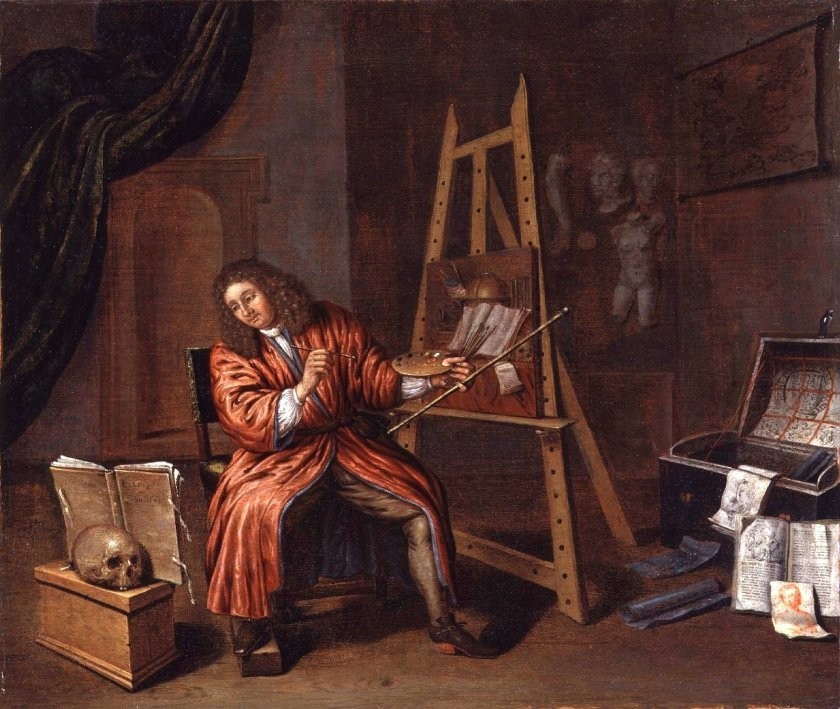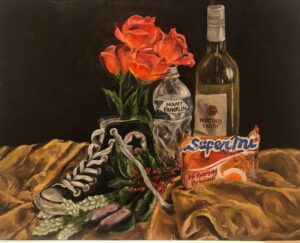Vanitas- Introduction
Vanitas is a genre of still-life painting that originated in the Netherlands during the 16th and 17th centuries. It explores themes of mortality, the transient nature of life, and the inevitability of death. Through symbolic objects such as skulls, hourglasses, and decaying flowers, Vanitas artworks invite viewers to reflect on the fleetingness of material possessions and the impermanence of earthly pleasures.
Vanitas- Introduction through upper written categories.
These two above written categories, “Artworks” and “Forms” comprise an essential aspect of the life of this artist. Vanitas is an art style of elite class which played a vital role in Vanitas renaissance movement.
You would know these things in this article:- Outside visual art,Etymology & Motifs.
There are other art movements such as “Fauvism,” “Minimalism,” and “Post-impressionism” which are similar to some extent.
Some artists of Vanitas come from other art styles such as Evert Collier, Harmen Steenwijck, David Bailly, Audrey Flack, and Georgia O’keeffe.
This art movement (Vanitas) has many famous paintings/artworks such as “Still life with skull,” “Pyramid of Skulls,” and “Large Vanitas.”
If you see the beauty of these paintings, then “Still Life with Skull” comes at first place which is beautiful, “Vanitas Still Life,” sometimes comes at the second place due to its demand.
If you (As a/an Vanitas student) really want to read comprehensively then read these sections– “Artworks (artistic approach)” and “Forms (Other aspects).”
These categories comprise in-depth knowledge, especially- “Artworks”-A Category.
VANITAS was an art movement, and if you want to read about Vanitas comprehensively, then you should also cover its most famous artist– Evert Collier, Harmen Steenwijck, David Bailly, Audrey Flack, and Georgia O’keeffe.
But if you have less time, then you may select- Vanitas Characteristic section.
Vanitas- Characteristics
Vanitas is a genre of still life painting that emerged in the 16th and 17th centuries in the Netherlands and later spread across Europe. These paintings are characterized by their symbolic representation of the transient nature of life, the inevitability of death, and the emptiness of worldly pursuits. Vanitas, meaning “vanity” in Latin, explores profound themes through visual symbolism and allegory. Here are some key characteristics of Vanitas paintings:
- Symbolic Objects: Vanitas artworks feature carefully chosen objects that serve as reminders of life’s brevity and fragility. These objects include skulls, hourglasses, extinguished candles, withered flowers, bubbles, soap bubbles, and decaying fruit. Each element holds symbolic meaning, representing the passage of time, the transience of beauty, and the impermanence of human existence.
- Memento Mori: Central to Vanitas art is the concept of memento mori, meaning “remember you will die.” Artists include skulls, bones, or other human remains to emphasize the inevitability of death and the temporary nature of worldly pleasures. Memento mori prompts viewers to reflect on the fleeting nature of life and the importance of contemplating one’s mortality.
- Material Wealth and Vanity: Vanitas paintings often depict opulent objects such as gold and silver vessels, jewelry, musical instruments, and luxurious fabrics. These symbols of material wealth highlight the transient nature of worldly possessions and the futility of pursuing materialistic desires. They serve as reminders that earthly riches hold no lasting value in the face of mortality.
- Religious and Spiritual Symbols: Vanitas artworks frequently incorporate religious and spiritual elements. Artists include religious texts, crucifixes, and religious icons to evoke contemplation of spiritual matters and the pursuit of salvation. These symbols encourage viewers to reflect on the spiritual dimensions of life beyond material pursuits.
- Moral Allegory: Vanitas paintings function as moral allegories, cautioning against excessive indulgence and attachment to worldly goods. By depicting decaying objects or symbols of impermanence, artists encourage viewers to contemplate the transient nature of life and the emptiness of material desires. The artworks prompt reflection on the value of virtue, the fleeting nature of earthly achievements, and the pursuit of deeper meaning.
- Subdued Color Palette: Vanitas artworks typically employ a muted color palette, with shades of browns, grays, and earth tones dominating the composition. This restrained use of color enhances the somber and introspective mood of the paintings, reinforcing the theme of transience and inviting viewers to reflect on the transient nature of existence.
Vanitas paintings serve as powerful reminders of the ephemeral nature of life and the futility of worldly pursuits. Through symbolic imagery, memento mori themes, and moral allegory, these artworks encourage viewers to contemplate the impermanence of human existence and the pursuit of spiritual enlightenment beyond material possessions.
Vanitas- 4 Frequently asked questions
Q1. What is Vanitas?
Vanitas is an art movement, and the Vanitas artist tries to express artistic thought through Vanitas paintings/artworks.
There are so many artists such as Evert Collier, Harmen Steenwijck, and David Bailly who defined this art style through their artworks such as “Still life with skull,” “Pyramid of Skulls” and “Large Vanitas.”
Thus Vanitas is a pastiche of many different art styles such as “Fauvism,” “Minimalism,” “Post-impressionism” etc.
Q2. Why is Vanitas still popular today?
There are two things, the demand of Vanitas paintings/artworks and fame of Vanitas artists. Still, there are many artworks which are in huge demand such as “Still life with skull,” “Pyramid of Skulls” and “Still Life with Skull.”
Still, there are many European exhibitions which display– “Still life with skull,” “Still Life with Skull,” “Large Vanitas.”
These Vanitas paintings show the popularity of this art style. Evert Collier, Georgia O’keeffe, and David Bailly are other factors of its popularity.
Q3. What do you think about Vanitas?
Vanitas is an artistic and intellectual art movement which has a complicated history; Vanitas was the way of expression for “Georgia O’keeffe,” “David Bailly,” and “Evert Collier.”
In philosophy and the history of ideas, this art style is very diverse. See category- “Artworks” and “Forms.”
You would get the depth of this art style, through Vanitas artworks, artists try to emphasize on the free flow of expression.
Artworks of Vanitas artists explore the relationship between celebrity culture (Artworks) and visual expression (Forms).
Q4. What are the features of Vanitas?
This art style is trendy; Vanitas emerged in 17th century as a/an Vanitas movement when there was artistic standoff among European countries.
Some artists such as “Audrey Flack,” “Evert Collier” and “Georgia O’keeffe.”
Actually, if you want to know the features of the Vanitas movement, then you should read about “Evert Collier” and “Harmen Steenwijck.” And you may also know it by going through these categories- “Artworks” and “Forms.”
These categories cover everything comprehensively.
Vanitas- Five topmost artists
1. Evert Collier
Born: 26 January 1642, Breda, Netherlands
Died: 8 September 1708, London, United Kingdom
Period: Baroque
Nationality: Dutch

2. Harmen Steenwijck
Born: 1612, Delft, Netherlands
Died: 1656, Leiden, Netherlands
Period: Baroque
Nationality: Dutch
On view: Rijksmuseum

3. David Bailly
Born: 1584, Leiden, Netherlands
Died: 1657, Leiden, Netherlands
Periods: Baroque, Dutch Golden Age
Education: Cornelius van der Voort

4. Audrey Flack
Born: 30 May 1931 (age 92 years), New York, New York, United States
Period: Photorealism
Spouse: H. Robert Marcus (m. 1970)
Education: Institute of Fine Arts, New York University (1953), MORE
Known for: Painting, Sculpture

5. Georgia O’keeffe
Born: 15 November 1887, Sun Prairie, Wisconsin, United States
Died: 6 March 1986, Santa Fe, New Mexico, United States
Periods: Modernism, Precisionism, American modernism
Spouse: Alfred Stieglitz (m. 1924–1946)
Awards: National Medal of Arts (1985), Presidential Medal of Freedom (1977), Edward MacDowell Medal (1972)

Vanitas- Introduction of these artists.
1st EVERT COLLIER– Evert Collier is the artist of Vanitas art movement who played a vital role in the Vanitas art movement renaissance, the date of birth of this artist is 26 January 1642, and the place of birth is- Pob1.
This artist is known for/as Denver Art Museum (Dutch Golden Age). Due to regional effect, Paintings of this Vanitas artist show resemblance with these areas. The artistic qualification of this artist is- Denver Art Museum (Dutch Golden Age).
But still, it’s a beauty of this Vanitas art movement that you may compare these artworks with each other- “Large Vanitas,” “Pyramid of Skulls,” “Still life with skull,” “Vanitas Still Life” and “Still Life with Skull.”
Notable works:- Self-Portrait with a Vanitas Still-life, 1684 & Circa 1695.
Qualification:- Denver Art Museum (Dutch Golden Age).
2nd HARMEN STEENWIJCK– The date of birth of Harmen Steenwijck is 1612, this artist was born during the Vanitas period when the Vanitas art movement was on the peak wherein Harmen Steenwijck had played a vital role in this art movement.
The date of birth of this artist is 1612, and the place of birth is- POB2. The artistic qualification of this artist is- Dutch Golden Age painter.
Notable works:- Vanitas stilleven, 1640 & Dutch East Indies.
Qualification:- Dutch Golden Age painter.
3rd DAVID BAILLY– This name also emerged during the Vanitas art movement. The artwork demand of David Bailly is a little bit lesser than Evert Collier.
But the artworks of this artist (David Bailly) are also very beautiful. The artistic qualification of this artist is- Flemish immigrant (Cornelius van der Voort).
Notable works:- Portraits of his students & Flowers and candles.
Qualification:- Flemish immigrant (Cornelius van der Voort).
4th AUDREY FLACK– The artistic qualification of this artist is- The High School of Music & Art (American artist). Audrey Flack is the artist of the Vanitas art movement who also played a vital role in the Vanitas art movement renaissance.
The date of birth of this artist is 30 May 1931, and the place of birth is pob4. This artist is known for/as The High School of Music & Art (American artist).
Notable works:- Banana Split Sundae, 1981 & Statue of Catherine of Braganza.
Qualification:- The High School of Music & Art (American artist).
5th GEORGIA O’KEEFFE– The date of birth of this artist is November 15, 1887, and the artistic qualification of this artist is- School of the Art Institute of Chicago (American artist). The artworks demand of Georgia O’keeffe is a little bit lesser than Evert Collier.
But then also, paintings of this Vanitas artist remain in high demand.
Notable works:- Blue and Green Music, 1921 & Pineapple Bud, 1939.
Qualification:- School of the Art Institute of Chicago (American artist).

Vanitas- Related art movements
- Memento Mori: Memento Mori is an art movement closely associated with Vanitas, originating in the same time period. It shares common themes centered around mortality and the transient nature of life. Both genres employ symbolic elements like skulls, hourglasses, and extinguished candles to provoke reflection on the inevitability of death.
- Baroque Still-Life: The Baroque still-life painting movement, prominent in the 17th century, exhibits similarities to Vanitas in subject matter and composition. Both genres often feature intricate arrangements of objects, symbolic imagery, and a focus on capturing textures and details. While Vanitas emphasizes mortality, Baroque still-life encompasses a wider range of subjects.
- Symbolism: Symbolism, a late 19th-century art movement, resonates with Vanitas thematically. Symbolist artists sought to evoke emotions and ideas through symbolic imagery, exploring spirituality, mortality, and the subconscious. Similar to Vanitas, Symbolism employs symbols and allegorical representations to convey deeper meanings and inspire contemplation in viewers.

Vanitas- Key facts
Vanitas is a genre of still life painting that emerged in the 16th and 17th centuries, particularly in the Netherlands. It is characterized by the inclusion of symbolic objects that convey profound themes related to the transient nature of life, the inevitability of death, and the vanity of worldly possessions.
Artists carefully selected symbolic objects to convey these messages in Vanitas paintings. These objects often included skulls, hourglasses, extinguished candles, withering flowers, mirrors, and musical instruments. Each object held its own significance, contributing to the overall narrative of the artwork.
The primary focus of Vanitas art was to evoke contemplation on the transience and fragility of life. Through the inclusion of decaying or ephemeral objects, artists aimed to remind viewers of the passage of time and the impermanence of material possessions. The Latin phrase “memento mori,” meaning “remember you must die,” often appeared in these artworks, urging individuals to reflect on their mortality and embrace spiritual and moral values.
Vanitas paintings frequently conveyed religious and moral messages, influenced by the Protestant Reformation in the Netherlands. They emphasized the ephemeral nature of earthly pursuits and encouraged viewers to prioritize spiritual and moral aspects of life.
The composition of Vanitas artworks typically featured carefully arranged still life setups. Artists skillfully played with light and shadow to create a sense of depth and highlight the symbolic objects within the composition.
Vanitas thrived during the Dutch Golden Age, a period of prosperity and cultural development in the Netherlands. Esteemed Dutch artists such as Pieter Claesz, Harmen Steenwijck, and Willem Claesz Heda made notable contributions to the genre.
The allegorical nature of Vanitas paintings allowed for diverse interpretations. While they served as cautionary reminders about the fleeting nature of worldly pleasures, they also prompted contemplation on the vanity of human achievements and the ephemeral nature of physical beauty.
Over time, the Vanitas genre evolved, incorporating different elements. Some variations included landscapes, portraits, or genre scenes subtly referencing the Vanitas theme. This expansion broadened the range of subject matter while retaining the symbolic elements.
Vanitas has had a lasting influence on the art world, inspiring generations of artists. Its symbolic and allegorical nature continues to resonate in contemporary art forms, such as photography, sculpture, and installations.
These key facts provide insights into the Vanitas genre, its historical emergence as a still life painting style, the symbolism inherent in its objects, its contemplation of life’s transience, and its enduring impact on the art world.
Vanitas- People also search for:-
Top artists (5):-
Top artworks (5):-
Related art movements (3):-



